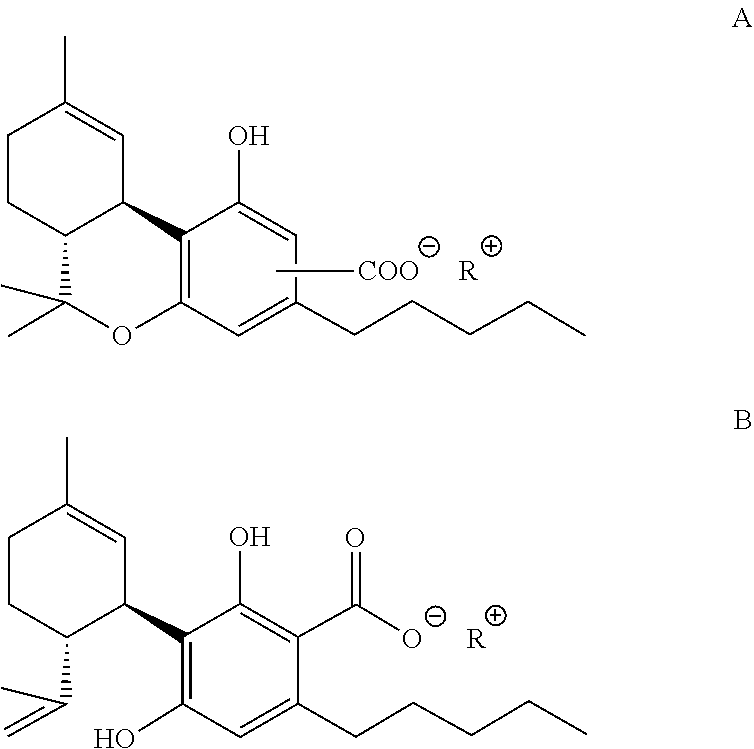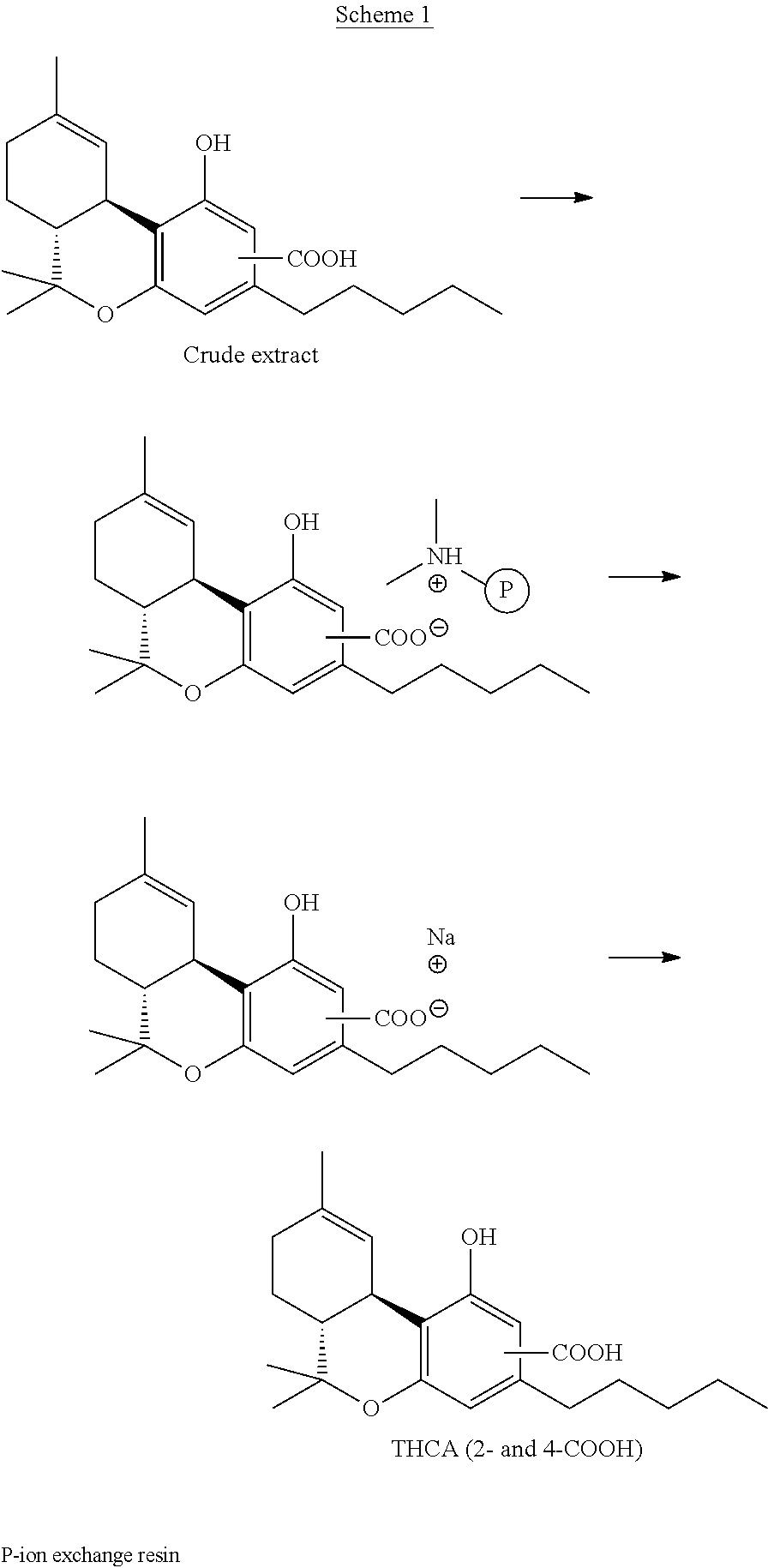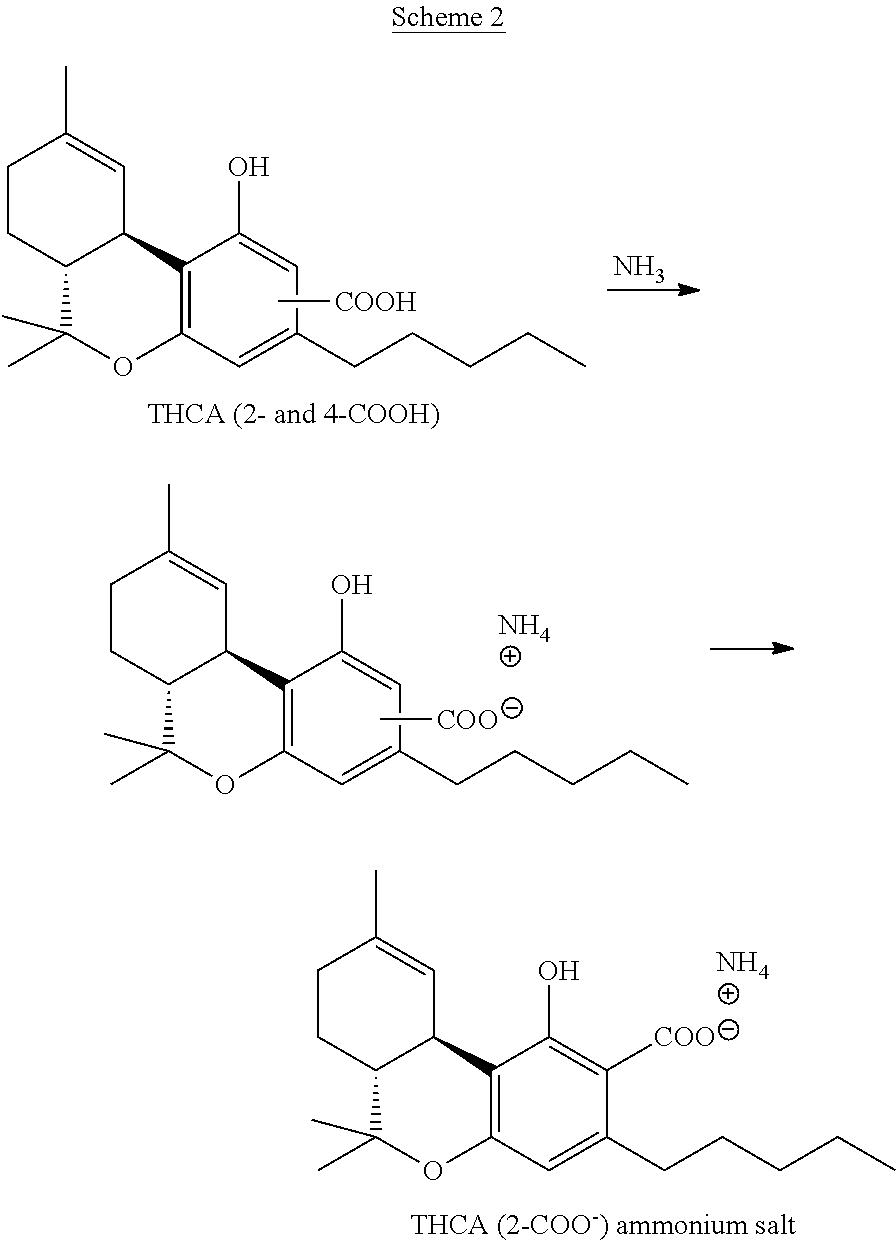Process for purification of tetrahydrocannabinolic- and cannabidiolic acid from plant material extract
a technology of tetrahydrocannabinolic and cannabinolic acid, which is applied in the field of purification of tetrahydrocannabinolicand cannabinolic acid from plant material extract, can solve the problems of strong limitations in the development of pharmacological cannabinoid applications and is not suitable for pharmacological purposes
- Summary
- Abstract
- Description
- Claims
- Application Information
AI Technical Summary
Benefits of technology
Problems solved by technology
Method used
Image
Examples
example 1
on of THCA (Both 2-COOH and 4-COOH)
[0042]As depicted in Scheme 1, dry plant material Cannabis sativa (10 g) was extracted with cyclohexane (150 ml) for one hour under N2 to prevent oxidation and filtrated. The solid was washed twice with 50 ml cyclohexane, and all solvents together were added to anion exchange resin Amberlyst® A21 (free base 3) and stirred for an hour. The degree of acid uptake was monitored by TLC. The resin was filtrated and washed twice with ethanol to remove cyclohexane traces (after distillation cyclohexane may be re-used). The resin was then added to a solution of NaOH (1.2 g, 30 mmol) in 150 ml 95% ethanol and the mixture was stirred for two hours. The resin was filtrated and washed twice with 50 ml ethanol (resin may be re-used). By HPLC, the solution contained Na-salts of THCA (2-COOH) and THCA (4-COOH) in amounts of 91% and 5%, respectively. All the solutions were added to ion exchange resin Dowex® 50WX8 (hydrogen form) and stirred for 30 min. The resin wa...
example 2
on of THCA (2-COOH) with Purity of >97%
[0043]As depicted in Scheme 2, to an ethanol solution of the THCA obtained in Example 1 (a mixture of 2-COOH and 4-COOH), 20 ml of 32% ammonia was added and the solvent was evaporated till oily residue was obtained. The product was dried in deep vacuum for 24 hours, then 150 ml heptane was added, and the mixture was stirred until white precipitate was obtained. After filtration, solid was recrystallized from MTBE-heptane and dried under vacuum. The yield of THCA (2-COOH) ammonium salt was 620 mg. Purity >97%. 1H NMR (CD3OD), δ: 0.88-0.91 (3H, t, CH); 1.06 (3H, s, CH); 1.31-1.43 (9H, m, CH); 1.51-1.55 (3H, m, CH); 1.57 (3H, s, CH); 1.65-1.90 (1H, m, CH); 2.13-2.14 (2H, m, CH); 2.51-2.59 (2H, m, CH); 2.92-3.17 (1H, d, CH); 3.31-3.32 (3H, d, CH); 6.03 (1H, s, CH); 6.47 (1H, s, CH). 13C NMR (CD3OD), δ: 14.51, 19.54, 23.55, 23.72, 26.27, 27.90, 32.29, 32.81, 33.35, 35.11, 36.64, 47.48, 78.49, 110.11, 110.70, 111.27; 126.06, 133.44, 146.71, 157.20, 1...
example 3
on of THCA (Mixture of 2-COOH and 4-COOH)
[0045]Dry plant material Cannabis sativa (10 g) was extracted with i-propanol (200 ml) containing 20 ml 25% solution of ammonia for one hour under N2 to prevent oxidation and filtrated. The solid was washed twice with 50 ml i-propanol, and all the solvents together were added to anion exchange resin Amberlyst® A21 (free base 3) and stirred for an hour. The degree of acid uptake was monitored by TLC. The resin was filtrated and washed twice with i-propanol to remove traces of ammonia solution (after distillation i-propanol may be re-used). Then resin was added to a solution of KOH (1.2 g, 20 mmol) in 100 ml i-propanol and the mixture was stirred for two hours. The resin was filtrated and washed twice with 50 ml of i-propanol (resin may be re-used).
[0046]All the solutions were added to ion exchange resin Dowex® 50WX8 (hydrogen form) and stirred for 30 min. The resin was filtrated and washed twice with 50 ml i-propanol. The solvent was evaporate...
PUM
| Property | Measurement | Unit |
|---|---|---|
| Pressure | aaaaa | aaaaa |
| Acidity | aaaaa | aaaaa |
Abstract
Description
Claims
Application Information
 Login to View More
Login to View More - R&D
- Intellectual Property
- Life Sciences
- Materials
- Tech Scout
- Unparalleled Data Quality
- Higher Quality Content
- 60% Fewer Hallucinations
Browse by: Latest US Patents, China's latest patents, Technical Efficacy Thesaurus, Application Domain, Technology Topic, Popular Technical Reports.
© 2025 PatSnap. All rights reserved.Legal|Privacy policy|Modern Slavery Act Transparency Statement|Sitemap|About US| Contact US: help@patsnap.com



